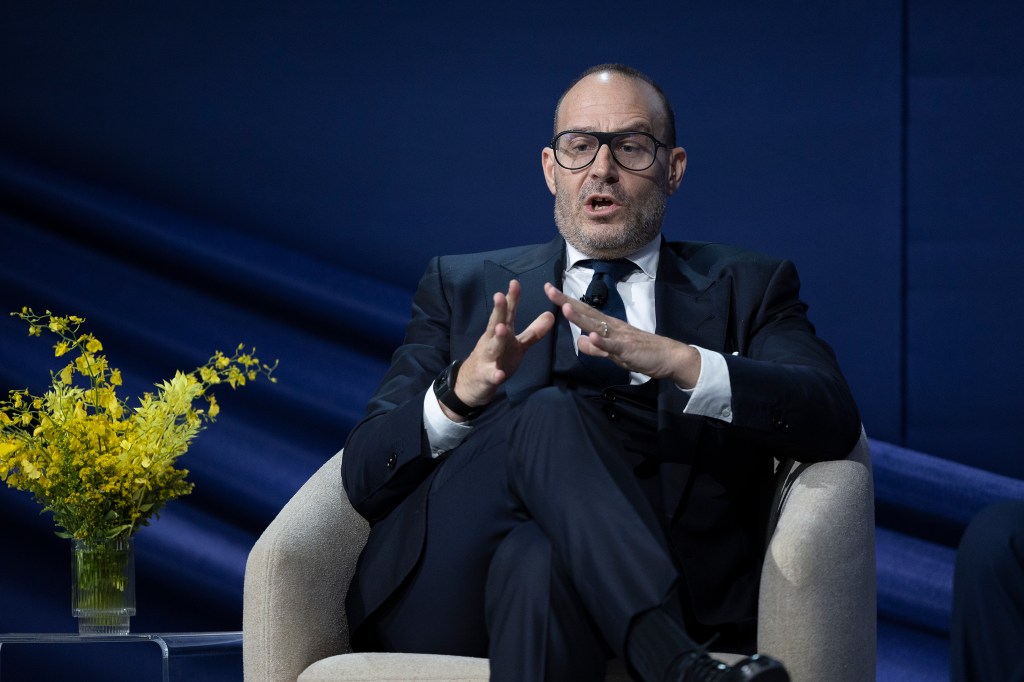As he appraises the luxury market, Saks chief executive officer Marc Metrick leans in on the long-term potential.
“When you ask me how the luxury market is doing, it’s turbulent. But luxury is going to grow. You can’t look at it as points in time. You need to be consistent. You need to be steadfastly committed to your strategy. Luxury will continue to grow and this is just a moment.”
That was Metrick’s main message to the audience at the WWD Apparel & Retail CEO Summit. He also spoke of Saks’ “three horizons” of growth, international potential, Barneys and the 2023 holiday season.
He said Saks, which is the e-commerce company for the Saks Fifth Avenue brand, just completed its “first horizon,” a period of growth from 2021 to 2022. “We more than doubled the business since before the pandemic on saks.com,” Metrick said. The company also increased its customer count to 3 million, with many newcomers to the brand, whom Metrick characterized as”emerging luxury consumers that could be aging into wealth or aging into the lifestyle, and likely to evolve into being considered core customers.” That’s where the lion’s share of growth came from, the Saks CEO said.
While phase one was growth, phase two was about “tilting” from customer acquisition to retention, and building loyalty and business with existing customers. “That’s where we are now…It’s about personalization. We have to take that to the next level, but not be spooky, to just serve you better and not waste your time,” Metrick said.
Customers require personalized experiences “so we’re not overwhelming them with choice,” Metrick said. “You have to be careful. The endless aisle is the customer’s worst experience. So technology and personalization are enabling your team to bring on a wider, deeper assortment without overwhelming the customer.”
The luxury consumer, he suggested, is the most resilient of any consumer sector in difficult economic times. “This consumer is ‘last in, first out’ of volatile moments, which we are in right now,” Metrick said. By that he means the luxury consumer is the last to restrain their spending in tough times, and the first to get back to spending as the economy starts to improve.
“If I was in the business of looking at the stock market every day and worrying about where the world is, what the Fed says, if it’s raining out, or if it’s unseasonably warm, you don’t have a business. Right? You’ve got to pick your spot, pick your strategy, you got to manage it, so you don’t shoot yourself. It’s about the long game,” Metrick said.
“Part of what differentiates one luxury company from another is how we emerged from the pandemic. At Saks, we made certain bets. We really make bets almost in six-month increments, because that’s when we commit. And that’s when our folks are out in the market. And that’s when they’re looking at fashion and knowing what’s going to come in.”
The split of Saks Fifth Avenue into separate e-commerce and stores companies in 2021 “enabled us to energize with a new hierarchy of KPIs, or key performance indicators, on how we operate the business, point to a different direction, set up a new North Star and drive the business that way. From a talent acquisition standpoint, the organization was reorganized with almost half of it new.” Insight Partners made a $500 million minority equity investment in saks.com in conjunction with the 2021 reengineering, enabling Saks to add talent, technology and categories where previously it only dabbled in, such as wellness, home, kids, golf and ski.
“If you go out to Silicon Valley, or Palo Alto, and you hold a sign up saying ‘now hiring’ for a department store, it’s quiet. You hold up that same ‘now hiring’ sign for a luxury pure play with massive growth potential, and people come. And so we were able to attract a whole different type of technology talent, augmenting an existing strong tech team, and bringing on new talent from non-retail disciplines,” Metrick said. “Of course, we got Amazon folks, people from Netflix, Airbnb and other companies that supercharged that growth from a staff standpoint.
“One of the first things we did was to challenge everything we’re doing,” Metrick noted. “With new people, you challenge them, because I find the biggest value you have is the first two months on the job, before you’ve been tainted and corrupted by all of this is what works, and this is what doesn’t work.”
On Saks’ growth potential overseas, Metrick said, “Based on the index of volume done on our gateway markets by international tourists — it’s been 20 percent — we know the Saks brand has legs. It’s portable.”
Any international effort will be done differently from the past. Rather than initially launching a licensed store in a mall from which Saks would collect royalties, “We would take the region as a whole, pick a partner in that region, and go digitally first into that region. We would learn, pick up the signals, get the data, and then open stores with a third party and build it that way.” Proceeding first with digital would better inform Saks on the composition of the population, whether it’s growing, and whether there is a change in tourism, when people spend more or less, among other how merchandise gets shipped and when people tend to spend more or less, among other insights.
“You need to go into a region in a much more amplified and pronounced way. We would have Tracy and her team involved with the merchandising, and Emily and her team involved in the marketing,” Metrick said, referring to Tracy Margolies, Saks’ chief merchandising officer, and Emily Essner, Saks’ chief marketing officer. Despite having overseas stores being licensed to third parties, “We still stay very close to the brand, especially as we grow it and ramp it. That would be the very big difference.…Then you have to look at the luxury space. Luxury is everywhere in the world. Is there still room between the brands that have their own operated stores, and the other retail that’s out there? You can’t open where there’s no room for you.”
For Saks, as Metrick sees it, there is room. “There are a few opportunities to regions that I see right now as being ones that check all those boxes.”
Outside the U.S., Saks has three company-owned stores in Canada and two licensed stores in Bahrain and Kazakhstan. At one time, Saks had two licensed stores in Mexico City, and two in the Middle East, in Dubai and Riyad. Those were all closed.
Touching on other topics, Metrick cited the value in using AI and analytics to guard against fraud, to know more about who’s shopping and how and distinguish the “bad actors” from everyone else “so we don’t have to have these monolithic Plexiglas processes and policies,” that while reducing theft also make the shopping difficult.
On his outlook for the holiday 2023 season, Metrick said, “Holiday always comes, and there’s self purchasing.”
Based on what the company learned from its Saks Luxury Pulse survey of 1,836 luxury consumers, 18 and older, from July 20 to July 24 this year, there is some bounceback to higher levels of spending occurring which should continue through holiday. “People are certainly planning on buying, people are planning on self purchasing. Who’s traveling over the holiday? People certainly plan on traveling,” Metrick observed.
In November 2019, Authentic Brands Group finalized a $271 million deal to buy Barneys New York out of bankruptcy and licensed Saks Fifth Avenue to open Barneys shops. There’s a Barneys at Saks Fifth Avenue department on the fifth floor of the Saks flagship in Manhattan. There’s also a Barneys shop in Greenwich, Conn. But people in New York and other cities miss the old Barneys.
Asked about plans for Barneys at Saks, Metrick replied, “It was intended to be something different,” from Barneys in the past. “And we work closely with ABG. We are doing unique things when they become available. Barneys at Saks has a unique place in our brand hierarchy and structure, and we do what we have to do to maintain that. I’m not saying there’s going to be anything explosive and big. But it’s something that we want to maintain and grow over the next couple of years. It’s going to be opportunistic, and we’re going to take it very, very carefully.”



